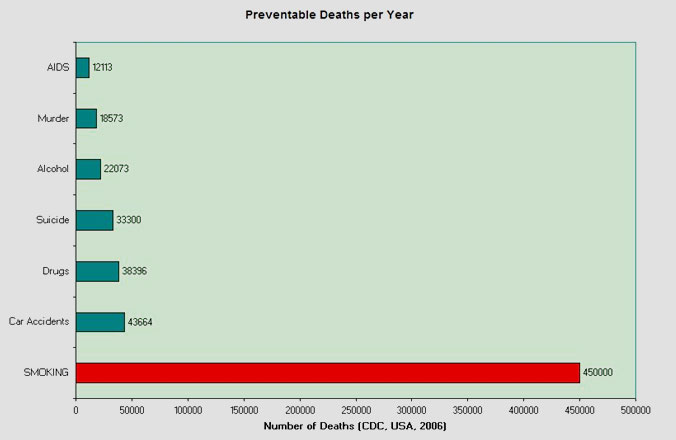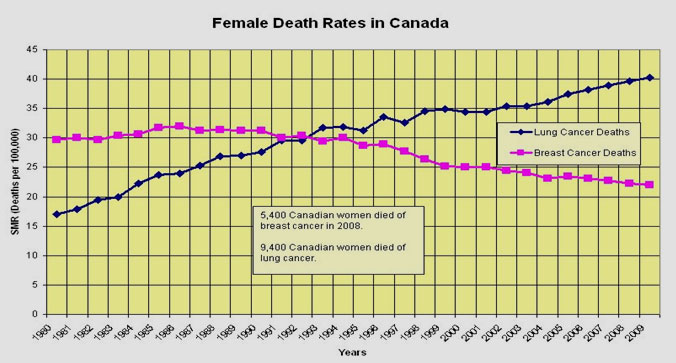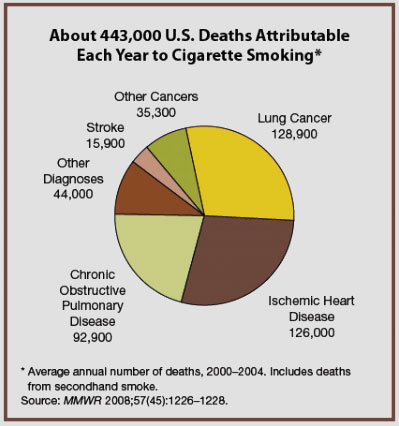GENERAL HEALTH RISKS OF SMOKING
Smoking is the #1 cause of preventable deaths in Canada and the United States. It kills more people every year than AIDS, murder, alcohol, suicide, drug use and car accidents combined.
The media tend to stress rare and unusual causes of death, such as plane accidents, West Nile virus or murder. Some diseases, such as AIDS, get a lot of publicity, even though every year thirty times more people die from smoking than from AIDS.Smoking kills 128 Canadians per day. Because they die one by one, spread across the country, they do not make the news. If only a few of them had died together in an accident, they would have made the headlines and everyone would want to know how we could prevent such a tragedy happening ever again.
Breast cancer gets a lot of media attention and funding through the “Pink Ribbon” campaign, but more Canadian women die from lung cancer due to cigarette smoking than from breast cancer, and lung cancer deaths are increasing while breast cancer deaths are declining.

If we could stop women from smoking, that would save more lives than finding a cure for breast cancer!
Smoking is a more important health risk than other issues such as high blood pressure, obesity, physical inactivity and bad diet. In a recent US study:
- Tobacco Smoking accounted 467,000 deaths.
- High blood pressure was responsible for about 395,000 deaths.
- Overweight-obesity accounted for 216,000 deaths.
- Physical inactivity was linked to about 191,000 deaths.
- High salt intake caused about 102,000 deaths(the most of any single dietary factor examined.)
(Danaei 2009)
Tobacco smoke contains chemicals that are harmful to both smokers and nonsmokers. There are 7,000 chemicals in tobacco smoke, of which 250 are known to be harmful (including hydrogen cyanide, carbon monoxide, and ammonia) and 69 can cause cancer.
The cancer-causing chemicals include the following:
- Arsenic
- Benzene
- Beryllium (a toxic metal)
- 1,3–Butadiene (a hazardous gas)
- Cadmium (a toxic metal)
- Chromium (a metallic element)
- Ethylene oxide
- Polonium-210 (a radioactive chemical element)
- Vinyl chloride
(National Cancer Institute web site, www.cancer.gov)
Smoking kills people in many ways. The most frequent method is lung cancer, followed closely by ischaemic heart disease (where smoking causes narrowing of the arteries which provide oxygen to the heart muscle, causing a heart attack). Chronic lung disease is the third major method, followed by a variety of other diseases, other cancers and stroke.

Smoking significantly decreases life expectancy:
- A 45 year old non-smoking man has a 90% chance of living to 65, and a 55% chance of living to 80, but a smoker of the same age has only an 80% chance of living to be 65, and a 30% chance of living to 80.
- One out of every two smokers will die of a smoking-related disease.
Smoking has been described as “probably the greatest health disaster in human history, being associated with more than 5 million deaths annually.” (Katznelson, 2011)
Clearly, smoking is a disaster for public health, but how does it impact surgery and anesthesia?



